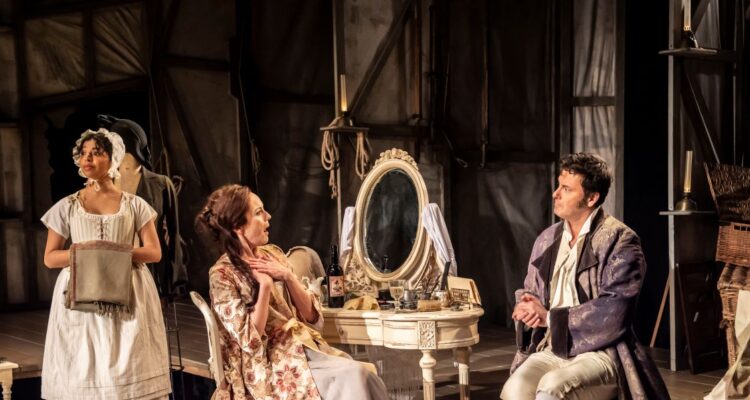If you head into Room 34 of the National Gallery you will find yourself surrounded by some of the best portraits of the great and the good of Georgian England. Most are swagger portraits of the nobility or military heroes, the sorts of people who could afford Gainsborough and Reynolds. But one of the very finest, a poised, carefully curated lady in fashionable dress, set against a velvet curtain, is a simple ‘Mrs Siddons’. A new play at Hampstead theatre sets out to explain how this could be….
Mrs Siddons was born as Sarah Kemble, a member of a distinguished theatrical dynasty. Indeed her most important relationship, as depicted in this play, was her tense, rivalrous partnership with her brother John Philip Kemble, who led and managed the Theatre Royal, Drury Lane, where Siddons reigned as leading lady for twenty years at the turn of the eighteenth and nineteenth centuries. Unlike other leading ladies, who played comedy and lived a life of celebrity scandals, Siddons mined the veins of regal tragedy, and cultivated an image of virtuous refinement that belied her humble origins and precarious fortune. Venturing into print herself, and using the portrait painters of the age to burnish her image, she exemplifies the opportunities and limits available to women in the contemporary public sphere.
De Angelis homes in on the price Siddons pays for negotiating this delicate balance: the continual requirement to earn because her feckless husband controls and mismanages her money; the separation from her children that touring entails and the egregious hate mail she receives for having to depart from gendered family expectations; the paucity of roles for independent-minded women of a mature age; the jealousy of male actors, and the tyrannical expectations of critics and censors. All this is well set out in a fine first act which takes us behind the scenes at Drury Lane, skipping between elements of stage performance, the back-and-forth of rehearsal, and dressing room banter. There are many amusing one-liners, and a good balance is struck between recreating the conventions and artifice of the Georgian theatre and accessibly modern dialogue.
However, in the second act we do not move far from this promising foundation. De Angelis seizes on the fact that Siddons often returned to perform readings of a play written by a female playwright to project an ultimately thwarted alternative future in which Siddons attempts tp take control of her career and reshape her image free of compromise. The themes reiterated here largely repeat those set out in the first half. The dramatic impulse flags and fragments, not least through the frequent asides to the audience – often a sign of problems when so much signage is needed. The play ends up feeling too long, and in the process you become aware of how two-dimensional most of the other characters are in service to the central iconic figure, as if they remain in a Hogarth engraving from which she alone has escaped.
It would churlish, however, not to acknowledge the distinction of individual contributions. The evening is dominated by Rachael Stirling’s evocation of Siddons herself. This is a deep and many-sided characterisation, with expert comic timing, diva charisma, and private fortitude all on display. You get to feel, as in so many plays that are about the business of acting, both the magnetism and the misery of celebrity. Dominic Rowan does his best with the role of her controlling, even bullying, brother, but I remain unconvinced that Kemble off-stage was quite the two-dimensional blowhard he clearly was on-stage. Anushka Chakravarti finds depth in the soubrette role of Patti, servant and confidante to Mrs S, while Gareth Snook offers a series of broad characterisations of a distgruntled actor and ingratiating critic. Sadie Shimmin likewise pops up in different guises, most notably as Mrs Larpent, wife of the chief censor, a kind of Mary Whitehouse figure conflicted between admiration of Siddons female power and thralldom to conventional morals. Eva Feiler completes the cast with a set of energetic roles, notably Joanna Baillie, the aspring female playwright, and Clara, a Siddons groupie, who pays the price for taking risks Siddons will not.
It is good to see that despite the recent financial challenges, Hampstead have commissioned an impressively authentic set from Lez Brotherston which gives us both the stage and backstage areas at Drury Lane, a delightful creamy-toned canvas in which the actors have great scope to play out scenes from real plays – such as ‘Macbeth’ – as much as the back-stage drama. Costumes likewise are lavish and period-precise. A fencing-bout, a feature of Siddons performance of ‘Hamlet’ in Dublin, is very plausibly done, and the lighting design defly deploys modern technology to capture the soft tones of eighteenth-century candlelight.
There are, indeed, many impressive individual aspects to the evening, but ultimately the glittering parts do not add up to a fully cohesive whole.
April De Angelis
Hampstead Theatre
Director: Anna Mackmin
Cast: Anushka Chakravarti, Eva Feiler, Dominic Rowan, Sadie Shimmin, Gareth Snook, Rachael Stirling
Photo Credit: Johan Persson
Until 27 April 2024
2 hrs 20 mins, with interval

